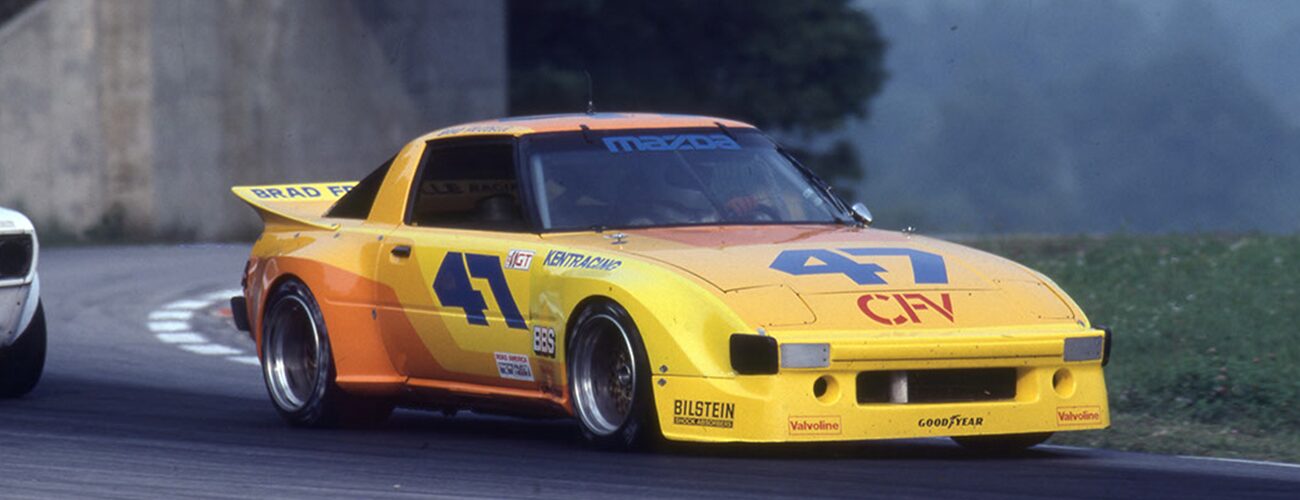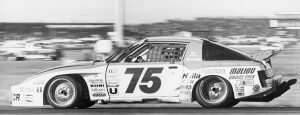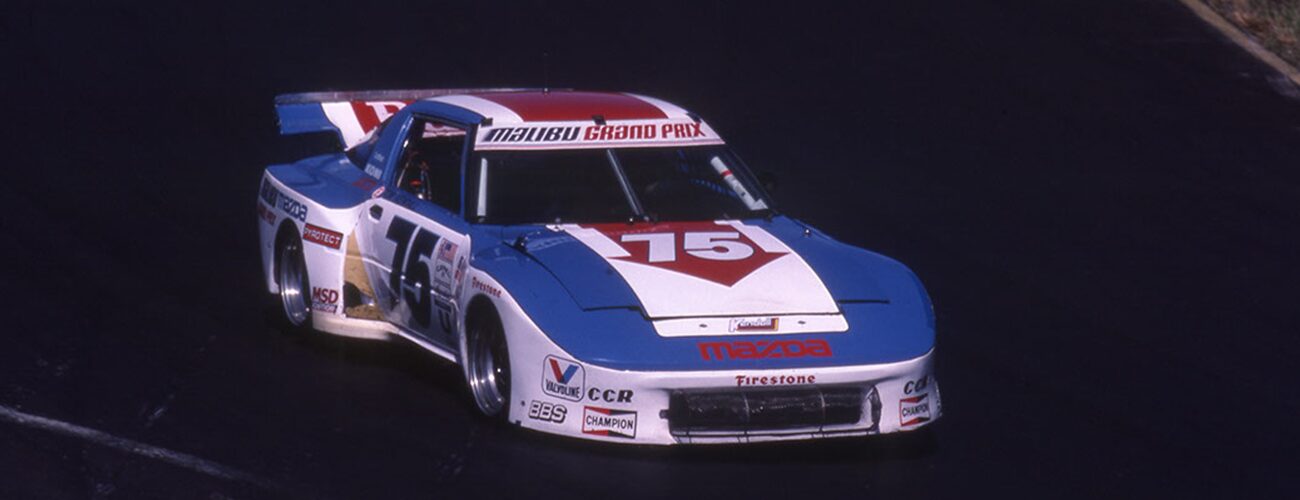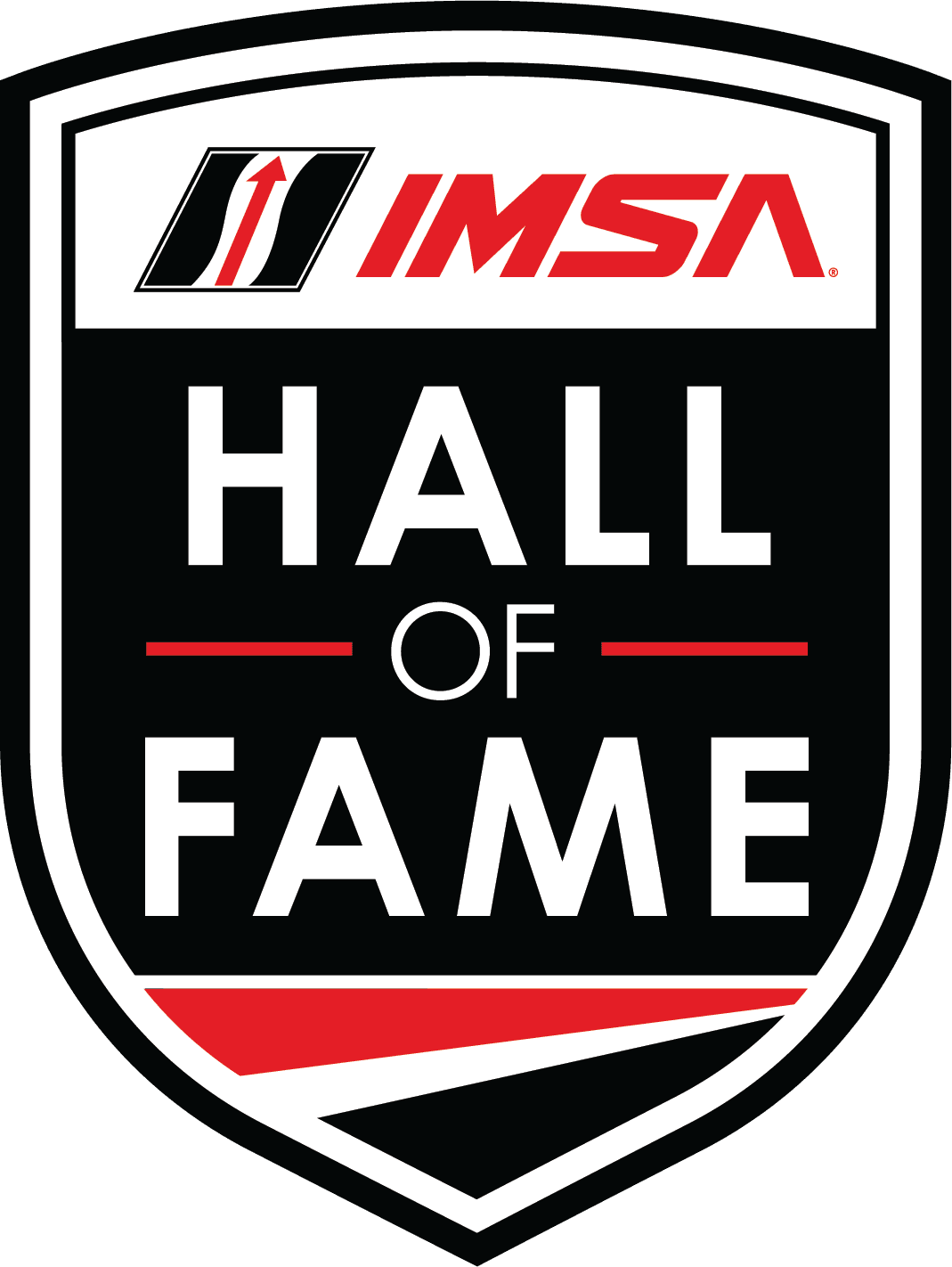Mazda
RX-7 GTU
INDUCTED:
2023
Mazda RX-7
By Marshall Pruett
Mazda’s RX-7 sang a wailing song that became the soundtrack for some of IMSA’s greatest achievements.
During the series’ formative 1970s and groundbreaking 1980s, the unmistakable sound of its twin-rotor Wankel engine, code named the ‘13B’ by the Japanese auto manufacturer, made the comparatively tiny two-door sports car an easy one to identify among the rumbling piston-driven engines in the GTO and GTU fields.
And thanks to its nimble handling and impeccable reliability, the RX-7 is also remembered as the model that launched the careers of legend after IMSA legend.
“It was definitely the most impactful car of my life because it took me from someone that nobody knew to a multiple-time champion,” says Tommy Kendall, who won two of his three GTU championships in a Clayton Cunningham Racing RX-7. “That Mazda is what led to me being signed with Chevrolet and becoming a factory driver for the rest of my time in the saddle. The RX-7 took me from the little leagues to the big leagues, and I was one of many who can look back and say that with a lot of pride.”
The car made an inauspicious debut at Mid-Ohio in August of 1978 in the hands of an ambitious sportsman by the name of Al Consentino, but it was the double factory entry from Mazda Japan at the Rolex At Daytona in 1979 that won the GTU class, and the wave of American privateers fielding rapid RX-7s of their own at the classic enduro, where Mazda became the new key to finding success in the category reserved for cars with engines under 2.5 liters in displacement.
Walt Bohren and the beloved Racing Beat RX-7 claimed Mazda’s first GTU championship in 1980 and was followed by 1981 title winner Lee Mueller in the powerhouse Kent Racing RX-7. Mazda’s GTU championship streak would continue as Jim Downing—‘Mr. Mazda’—claimed the ’82 GTU crown with his Georgia-based team, and in 1983, Roger Mandeville’s self-run RX-7 program ensured his name was inscribed on the GTU champion’s trophy.
Jack Baldwin took the RX-7 baton from Mandeville and went back-to-back with the red-white-and-bule Malibu Grand Prix Mazda RX-7 as the 1984 and 1985 GTU titles fell in his favor. Scott Pruett’s peerless history is heavily associated with bellowing V8s and all manner of championships earned over four decades, but on the road to becoming North America’s winningest sports car driver, the ageless wonder’s introduction to IMSA and all the glory that would follow sprang forth during Baldwin’s championship years in 1984-1985 as Pruett shined on regular occasion in a smaller Mazda RX-7 program.
Like Pruett, Kendall built the foundation of his triumph-laden career from within the cabin of an RX-7-- the ex-Baldwin car--and captured the 1986 and 1987 GTU titles, which sealed the brand’s incomparable streak of eight consecutive Drivers’ championships along with numerous Rolex 24 and 12 Hours of Sebring victories amassed over that period.
Akin to the passing of a career-igniting torch, Pruett, then Kendall fired themselves into sports car racing’s stratosphere with the RX-7, and next on the list was their fellow Californian Bill Auberlen, who motored ahead of Pruett in 2020 and has sole ownership of the all-time victory record. In their tradition, Auberlen began making his IMSA name in 1988, in a Mazda RX-7s.
It was never the most powerful car in GTU, nor was it accused of being the best in any specific performance category, but as whole, the gorgeous coupe was the remarkably good in all areas, a giant killer that doubled as a giant maker.
“What made it good was it was just reliable,” says Kendall’s chief mechanic Dan Binks, the Corvette Racing legend who got his start wrenching on the iconic No. 75 CCR RX-7. “Once we went away from the stock transmission and went to the 5-speed made by PBR, that solved a major problem. The engines made about 300hp and did that all day and the PBRs would handle it, no problem.
“It had a McPherson strut for the front suspension, which wasn’t ideal, but the trick at the back was to use a Mazda pickup truck rear end. That originally had a 4-link suspension arrangement, but then we converted it to a 3-link, which took a lot of the binding out and made it handle better than a lot of things in the class.”
Against serious efforts from Pontiac, Porsche, Toyota, and others, Mazda RX-7s filled IMSA’s history books with statistics that seem implausible yet also explain why the twin-rotor machines owned its rivals through its final title taken in 1987.
At the conclusion of that championship swansong season, IMSA’s list of all-time top-10 finishes was owned by RX-7 pilots, led by Downing in 1982 with 18 top 10s from 19 starts. Mandeville was second with a perfect 17-of-17 in 1986, and Kendall matched the feat in his farewell to Mazda, delivering 17 top 10s from 17 starts in 1987. Baldwin, Kendall’s brother Bart, and another Mazda legend, Amos Johnson, also reside in the sharp half of the finishing-record list.
“It just would keep running, and most of the other guys would break, especially in the longer races,” Binks said. “You couldn't kill it. Just couldn't. And we tried a couple times! Once you figured it out, that thing was unstoppable.”
Kendall raced the fastest IMSA GTP cars, rocketed around Daytona’s banking at 200-plus mph in prowling GTO cars, and competed with distinction at the 24 Hours of Le Mans. Set against those hallmarks, it’s telling how that No. 75 Mazda still brings a big smile to his face when the memories come rushing back.
“It reminded me of a squirrel!” Kendall says with a laugh. “They're all hyper and spastic and high strung and have big personalities. That was the RX-7. You could hear it for days. I still hear it now. I love it. It’s a wonderful choice for the IMSA Hall of Fame, if I do say so.”
Photo Gallery


















